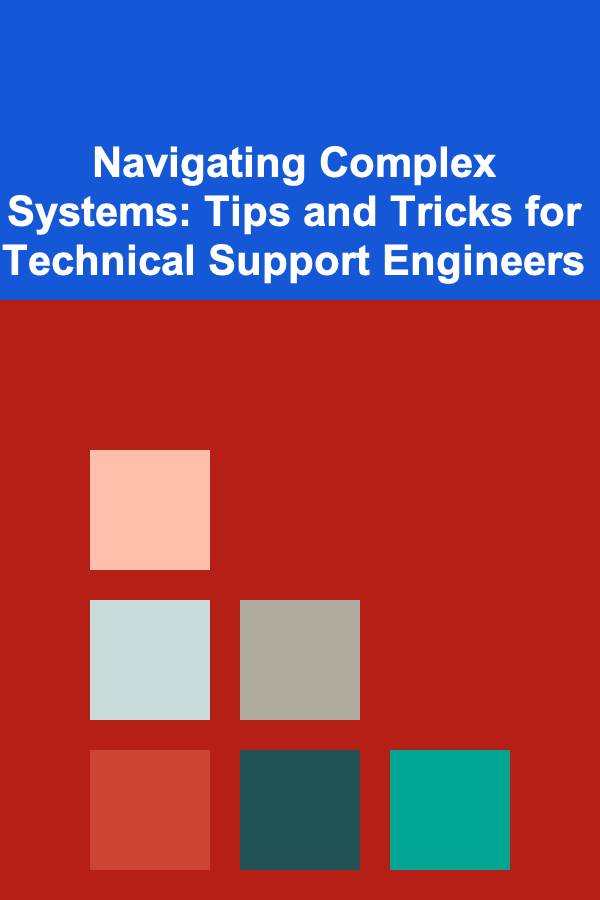
Navigating Complex Systems: Tips and Tricks for Technical Support Engineers
ebook include PDF & Audio bundle (Micro Guide)
$12.99$9.99
Limited Time Offer! Order within the next:

As a technical support engineer, navigating complex systems can be both rewarding and challenging. Complex systems often involve multiple layers of technology, intricate dependencies, and intricate configurations that can make troubleshooting seem daunting. Whether you are dealing with a large enterprise application, a network infrastructure, or a cloud-based service, understanding how to approach and manage these systems is key to providing effective solutions.
This actionable guide will help you develop strategies and techniques for navigating complex systems, troubleshooting effectively, and delivering excellent technical support. By adopting the following best practices, you'll be better equipped to handle the intricacies of complex systems and excel in your role as a technical support engineer.
Understand the System Architecture
Before you can troubleshoot effectively, you need to have a solid understanding of the architecture of the system you're supporting. This includes knowing how the system is designed, its components, and how they interact with one another.
Key Areas to Focus On:
- Components and Modules: Break down the system into its core components. Whether it's a multi-tier web application, a distributed database system, or a complex cloud infrastructure, understanding the individual modules will help you identify where an issue might be originating.
- Interdependencies: Complex systems often involve interdependent services or components. A failure in one part of the system can have cascading effects on others. Familiarize yourself with how different pieces of the system rely on each other.
- Data Flow: Understand how data moves through the system, from input to processing to output. Tracking data flow will often lead you directly to the source of the problem.
Actionable Tip:
- Take the time to review architecture diagrams, system documentation, and product specifications. If available, leverage monitoring and diagnostic tools that show real-time system interactions. Understanding the architecture will allow you to spot potential weak points or areas most susceptible to failure.
Master the Tools at Your Disposal
Complex systems often require specialized tools for monitoring, diagnosing, and troubleshooting. Whether it's log aggregators, performance monitors, or network analyzers, becoming proficient with the tools available to you is essential for success.
Recommended Tools:
- Log Aggregation Tools: Tools like Splunk, ELK Stack (Elasticsearch, Logstash, Kibana), or Datadog help consolidate logs from various parts of the system. This can be invaluable in tracking down the root cause of an issue by providing a unified view of events and errors.
- System Monitoring Tools: Tools like Prometheus, Nagios, or Zabbix allow you to monitor the health of different system components in real time. Setting up alerts for key performance indicators (KPIs) can help you spot issues before they escalate.
- Network Diagnostic Tools: Use tools like Wireshark, tcpdump, or NetFlow analyzers to troubleshoot network-related issues. These tools help you capture and analyze network traffic to identify bottlenecks or disruptions.
Actionable Tip:
- Familiarize yourself with at least one tool in each category: log aggregation, system monitoring, and network diagnostics. Regularly practice using them in simulated troubleshooting scenarios to become quicker and more effective in real-world situations.
Leverage a Systematic Troubleshooting Approach
When troubleshooting complex systems, it's easy to become overwhelmed. The key is to approach each problem methodically to break it down into manageable parts. A structured approach ensures that no steps are overlooked and helps you identify the root cause more efficiently.
Troubleshooting Frameworks:
- Divide and Conquer: Break down the problem into smaller, more manageable parts. Instead of trying to fix everything at once, tackle each component or system individually. Isolate where the issue is occurring---whether it's in the network, database, or application layer---and address it in stages.
- The Scientific Method: Approach the issue like a scientist. Form a hypothesis based on the symptoms you see, test it through controlled experiments, and then either confirm or reject it based on the results. Document your process so you can learn from each case and apply that knowledge to future problems.
- The Five Whys: This technique involves asking "Why?" repeatedly (usually five times) to get to the root cause of an issue. It's particularly useful when you notice recurring problems. By digging deeper, you may uncover systemic issues that need to be addressed.
Actionable Tip:
- Maintain a checklist of common troubleshooting steps tailored to the system you support. Include everything from checking hardware components to running diagnostic commands. Having a structured process in place reduces the chance of skipping critical steps during troubleshooting.
Understand the Customer's Context
In complex systems, the issue you're dealing with might not always be clear. Customers might report vague problems, or the symptoms could be misleading. To resolve issues effectively, you need to get a clear understanding of the customer's context---what they're trying to accomplish, the environment in which they're working, and any unique variables that might impact their system.
Best Practices:
- Clarify the Issue: Ask detailed questions to gather as much information as possible. What exactly is happening? When did the issue first occur? What were the system conditions before the issue arose? The more you know, the better you can tailor your troubleshooting approach.
- Recreate the Problem: If possible, try to replicate the issue in a test environment. This will help you narrow down the cause and determine if the problem is related to specific configurations, permissions, or system settings.
- Take a Holistic View: Understand the broader context in which the issue is occurring. Is it happening under high load? Is the issue isolated to one user or affecting multiple users? What recent changes to the system might have triggered the issue?
Actionable Tip:
- Use a collaborative ticketing system to track customer issues and document key information, such as steps to reproduce, environmental details, and previous troubleshooting attempts. This record will help you provide context when escalating issues or collaborating with other teams.
Collaborate with Cross-Functional Teams
When troubleshooting a complex system, you'll often need to work with other teams, such as development, network, or security teams. Collaboration is crucial for resolving issues faster and more effectively.
Key Collaboration Practices:
- Escalation Protocols: Understand when and how to escalate an issue to higher-level support teams or developers. If the problem requires in-depth technical expertise, you can save time by quickly directing the issue to the right person.
- Knowledge Sharing: Share insights and knowledge from your troubleshooting process with other team members. This collaborative approach ensures that everyone is on the same page and helps speed up the problem resolution process.
- Join Daily Standups or Sync Meetings: Participate in cross-functional meetings to stay up-to-date with ongoing system changes or upcoming deployments. This helps you prepare for potential issues and understand what changes might affect the system.
Actionable Tip:
- Build strong relationships with key people in other departments. A good working relationship with developers, for example, can make it easier to quickly obtain clarifications or escalate issues when needed.
Monitor and Prevent Recurring Issues
Once you've solved a complex problem, it's essential to ensure that the issue doesn't recur. Proactive monitoring, combined with proper post-resolution analysis, can help identify and prevent issues before they impact the system again.
Post-Resolution Best Practices:
- Root Cause Analysis (RCA): After resolving an issue, conduct an RCA to understand why it happened in the first place. This helps you identify the systemic changes that need to be made to prevent future occurrences. For example, a bug in the application might need a fix in the next software release.
- Set Up Alerts: Once the issue is resolved, set up alerts or automated monitoring tools to track any future anomalies or performance degradation in the affected area. Proactive monitoring can help you detect problems early before customers are impacted.
- Continuous Improvement: Use the lessons learned from each issue to improve system stability. Whether it's implementing better testing practices, refining your troubleshooting process, or improving communication across teams, continuous improvement ensures that you can handle more complex problems in the future.
Actionable Tip:
- Create a post-incident report after significant issues, detailing the problem, how it was resolved, and any steps taken to prevent future occurrences. Share this report with relevant teams to improve the system's resilience and your troubleshooting approach.
Keep Learning and Adapting
Technology is constantly evolving, and the systems you support are likely to change over time. To stay effective as a technical support engineer, you need to keep learning and adapting to new technologies, tools, and best practices.
Ways to Stay Up-to-Date:
- Take Online Courses and Certifications: Stay on top of the latest developments in your field by enrolling in courses related to cloud computing, network security, or specific tools you use regularly.
- Engage with the Community: Participate in online forums, attend industry conferences, or join professional organizations. Engaging with the broader tech community will help you stay informed and learn from others' experiences.
- Review Post-Mortems and Case Studies: Many companies share post-mortems of large system outages. Reviewing these case studies will expose you to real-world scenarios and the solutions that were implemented.
Actionable Tip:
- Set a personal development goal to learn something new every month, whether it's a new tool, system, or concept. Regularly dedicate time to upskilling and challenging yourself with new technologies.
Conclusion
Navigating complex systems as a technical support engineer can be a challenging but rewarding experience. By mastering the architecture of the system, using the right tools, applying systematic troubleshooting approaches, and collaborating effectively with cross-functional teams, you can become a highly effective problem-solver. Keeping the customer's context in mind and focusing on long-term improvements will also help you prevent recurring issues and elevate the overall user experience.
Ultimately, the key to success in supporting complex systems is a blend of deep technical knowledge, effective communication, and a proactive, customer-focused approach. By following the tips and strategies outlined in this guide, you'll be well on your way to mastering complex systems and providing top-tier technical support.
Reading More From Our Other Websites
- [Polymer Clay Modeling Tip 101] The Art of Celebration: Best Polymer Clay Wedding Cake Toppers & Sculptures
- [Hiking with Kids Tip 101] Kid-Friendly Backpacking: Essential Gear and Packing Lists for a Multi-Day Adventure
- [Personal Investment 101] How to Invest in Blockchain Technology Beyond Cryptocurrencies
- [Home Lighting 101] How to Select the Right Lighting for Your Home's Artwork
- [Personal Care Tips 101] How to Manage Dry Scalp Naturally in Winter
- [Organization Tip 101] How to Use Shelving to Showcase Dining Room Essentials
- [Reading Habit Tip 101] Beyond Fiction: Exploring Non-Fiction Genres That Transform Adult Lives
- [Personal Care Tips 101] How to Get the Most Out of Your Perfume Collection
- [Scrapbooking Tip 101] Tiny Treasures: Creative Themes for Your Mini Scrapbook Album
- [Home Cleaning 101] How to Clean a Toilet: Step-by-Step Guide for a Spotless Bowl

Earning Passive Income through Deep Learning Automation
Read More
How to Build a Retirement Planning Checklist for Planning Post-Retirement Activities
Read More
How to Handle Incoming Paperwork to Reduce Clutter
Read More
How to Start a Tutoring Center
Read More
How To Learn Basic Survival Skills
Read More
Creating Engaging Content for Webinars: A Comprehensive Guide
Read MoreOther Products

Earning Passive Income through Deep Learning Automation
Read More
How to Build a Retirement Planning Checklist for Planning Post-Retirement Activities
Read More
How to Handle Incoming Paperwork to Reduce Clutter
Read More
How to Start a Tutoring Center
Read More
How To Learn Basic Survival Skills
Read More